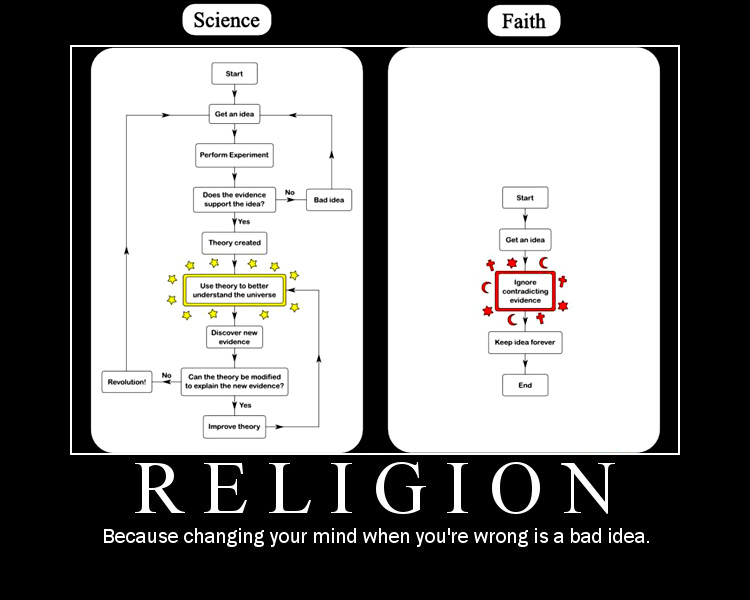edthecynic
Censored for Cynicism
- Oct 20, 2008
- 43,044
- 6,883
- 1,830
Simply put, you continue to take little snippets out of context, quote mining, in a dishonest attempt to "prove" a point.The question has been answered quite accurately. Repeatable experiments have demonstrated that light behaves as both a wave, such as interference, diffraction and polarization, and as a particle, such as the photoelectric effect.It's pretty clear why you don't want to answer the question.
Witness is excused.
Take Mini with you....
Results of the experiments and not faith leads science to the wave/particle duality of light.
A good lawyer never asks a question they don't already know the answer to, but a know-it-all will.
It seems that you have nothing left but vituperation...
...understandable.
'Cause you're fibbing.
"Light is both like a wave and like a particle, this on the level of individual photons themselves! The wave, it seems can pass through two slits, as waves do but to attest to a single particle may divide in the same way, requires lets call it an element of belief!"
"Waveparticle duality postulates that all particles exhibit both wave and particle properties. A central concept of quantum mechanics, this duality addresses the inability of classical concepts like "particle" and "wave" to fully describe the behavior of quantum-scale objects."
Wave
"...inability of classical concepts like "particle" and "wave" to fully describe..."
Simply put...the theory makes no sense...but you will continue to genuflect before the alter of quantum mechanics....because...
....get ready....
.....because you have faith.
Hey, would it be correct to call you the 'acolyte of astronomy'?
The 'reverend of research'?
How about 'the groupie of the Greenwich Observatory'??
The lap-dog of light theory?
Now, I know it's naughty of me to giggle at you like this, Beets....but, really, you deserve it.
You seem to accept the wave nature of light according to two slit experiment, but deny the particle nature of light, so I have taken this passage, from your OWN Wave link, on the photoelectric effect, that I mentioned in my previous reply that you chose to ignore. Again you can see that the particle nature of light was determined by repeatable experiments and not by faith.
Photoelectric effect illuminated
Yet while Planck had solved the ultraviolet catastrophe by using atoms and a quantized electromagnetic field, most physicists immediately agreed that Planck's "light quanta" were unavoidable flaws in his model. A more complete derivation of black body radiation would produce a fully continuous, fully wave-like electromagnetic field with no quantization. However, in 1905 Albert Einstein took Planck's black body model in itself and saw a wonderful solution to another outstanding problem of the day: the photoelectric effect. Ever since the discovery of electrons eight years previously, electrons had been the thing to study in physics laboratories worldwide. Nikola Tesla discovered in 1901 that when a metal was illuminated by high-frequency light (e.g. ultraviolet light), electrons were ejected from the metal at high energy. This work was based on the previous knowledge that light incident upon metals produces a current, but Tesla was the first to describe it as a particle phenomenon.
The following year, Philipp Lenard discovered that (within the range of the experimental parameters he was using) the energy of these ejected electrons did not depend on the intensity of the incoming light, but on its frequency. So if one shines a little low-frequency light upon a metal, a few low energy electrons are ejected. If one now shines a very intense beam of low-frequency light upon the same metal, a whole slew of electrons are ejected; however they possess the same low energy, there are merely more of them. In order to get high energy electrons, one must illuminate the metal with high-frequency light. The more light there is, the more electrons are ejected. Like blackbody radiation, this was at odds with a theory invoking continuous transfer of energy between radiation and matter. However, it can still be explained using a fully classical description of light, as long as matter is quantum mechanical in nature.[5]
If one used Planck's energy quanta, and demanded that electromagnetic radiation at a given frequency could only transfer energy to matter in integer multiples of an energy quantum hν, then the photoelectric effect could be explained very simply. Low-frequency light only ejects low-energy electrons because each electron is excited by the absorption of a single photon. Increasing the intensity of the low-frequency light (increasing the number of photons) only increases the number of excited electrons, not their energy, because the energy of each photon remains low. Only by increasing the frequency of the light, and thus increasing the energy of the photons, can one eject electrons with higher energy. Thus, using Planck's constant h to determine the energy of the photons based upon their frequency, the energy of ejected electrons should also increase linearly with frequency; the gradient of the line being Planck's constant. These results were not confirmed until 1915, when Robert Andrews Millikan, who had previously determined the charge of the electron, produced experimental results in perfect accord with Einstein's predictions. While the energy of ejected electrons reflected Planck's constant, the existence of photons was not explicitly proven until the discovery of the photon antibunching effect, of which a modern experiment can be performed in undergraduate-level labs.[6] This phenomenon could only be explained via photons, and not through any semi-classical theory (which could alternatively explain the photoelectric effect). When Einstein received his Nobel Prize in 1921, it was not for his more difficult and mathematically laborious special and general relativity, but for the simple, yet totally revolutionary, suggestion of quantized light. Einstein's "light quanta" would not be called photons until 1925, but even in 1905 they represented the quintessential example of waveparticle duality. Electromagnetic radiation propagates following linear wave equations, but can only be emitted or absorbed as discrete elements, thus acting as a wave and a particle simultaneously.

 Yeah, okay buddy.
Yeah, okay buddy.


